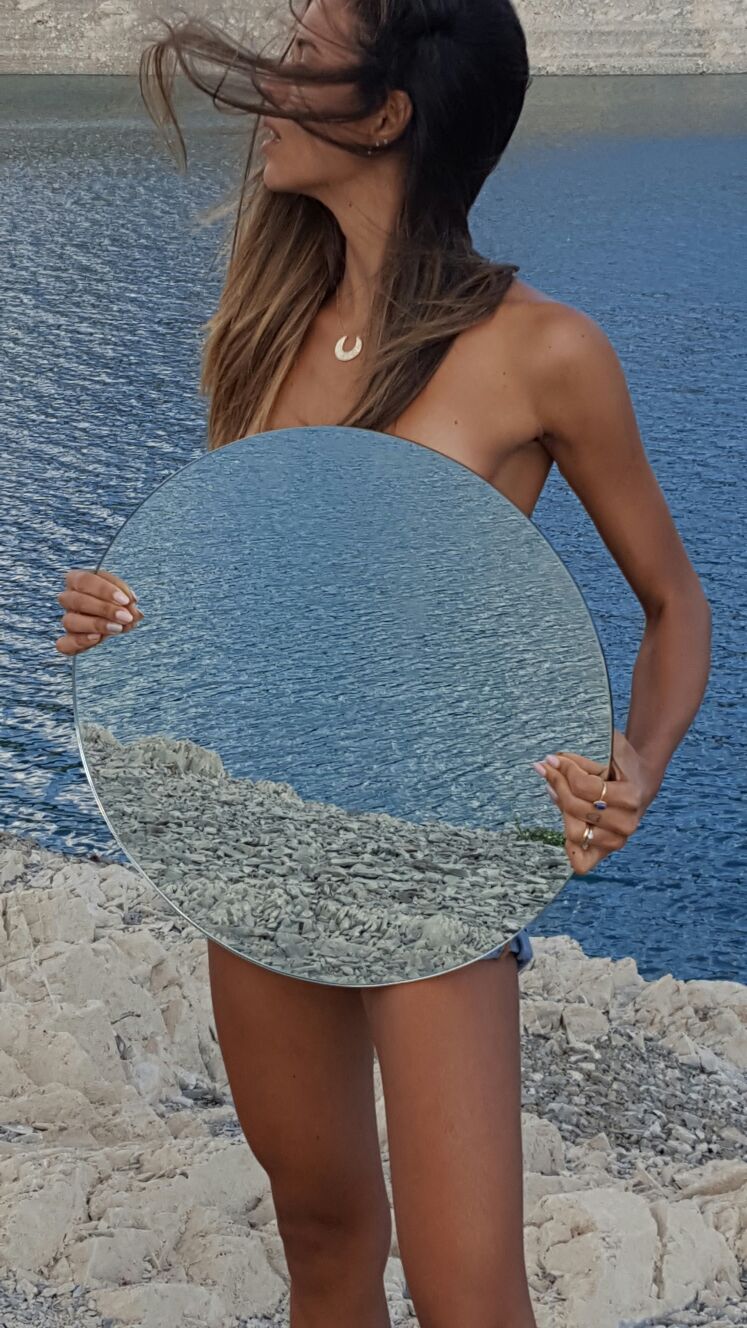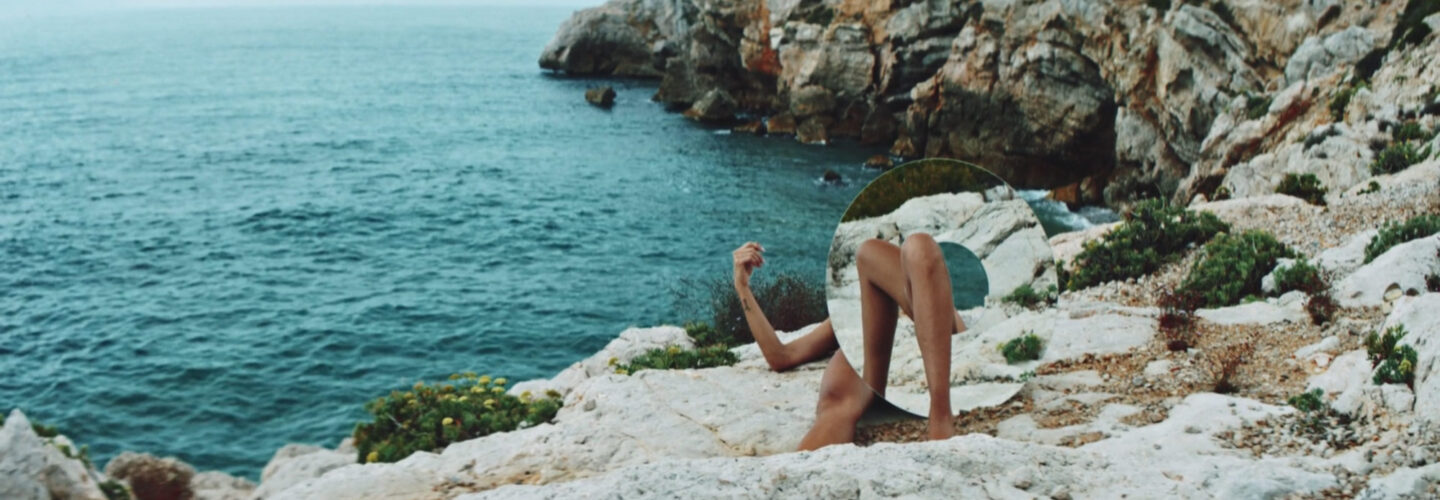
Drawing inspiration from the artists who have gone before them, This is Felo – otherwise known as husband and wife directing team Fermín Cimadevilla and Lorena Medina – bring their own expression of the mirror installation art piece to the Barcelona coast for Stop Us, the debut music video from French electro pop artists Siyyu. We dive into the unreality of the film’s looking-glass frames with the couple and discover how they crafted this oneiric trip of overwhelming landscapes and anonymous bodies.
Don’t Look feels very much like an art piece sitting within a music video wrapper – a feeling reinforced by the rotated credits. Where did the idea come from?
Your perception is correct, the music video is definitely conceived as an art piece. There are many artists such as Cody Smith, Jeppe Hein, Daniel Kukla and Shirin Abedinirad that have inspired us by exploring the use of mirrors as expressive elements in surprising and creative ways. Their art has transcended galleries and museums and has become more accessible and visible in the past recent years. Our video might be just one more piece behind #mirrors. The mirror might be the oldest visual effect that exists! It’s capacity to engage the senses in such a simple way is something that fascinates us as visual creators. Being able to observe two different realities that can help discover a new perspective and uncover its mysteries, creating a new envisioned reality. This is a concept that we had wanted to explore for a long time. The credits designed by Huizi Clavier challenges the observer with the kind of idea more frequently found in a conceptual artistic piece than in a promo. You can’t read the credits, you have to force yourself to read them. We loved the idea of using them as reflections since the very beginning.
Was it difficult to convey such an abstract concept to Siyyu in the initial stages?
When we first listened to Stop Us it was an immediate connection with our existent research. They loved the concept and the ideas flowed easily in a conversation with the artist. Together we added more depth to the idea and the collaboration payed well.


The use of mirrors extends the images beyond the confines of the frame, playing visual tricks on the viewer. How did you go about setting the scenes?
The close collaboration with our Art Director Stephane Carpinelli and our DP Jose Luis Bernal was fundamental for the settings. Initially we though about working with dolly and tracks to create long movements that were very stable and clean, but we finally decided to work with a steadycam to create floating movements with slight imprecisions and to leave the stiffness to the structures. We sacrificed technicism for something more organic.
Stephane had some great ideas for mirror design and composition and together we worked on the scouting to see which set of mirrors would be used in each location. We had a variety of shapes and sizes, and more importantly, we had created a handful of mirrors specially designed for some of the settings, such as the large L shaped mirrors, the donut shaped mirror and the half donut shaped mirrors. We made a plan based on the structure we had planned for the song and the characteristics of each location, but on top of that there was room for improvisation, which is always key in any creative process. We were like children, always searching for new images that could be found through the looking-glass.
We were like children, always searching for new images that could be found through the looking-glass.
What were the practicalities and challenges of creating and then working with the mirrors on location? I’m presuming that they weren’t made from glass.
You’re wrong in your presumption. All the mirrors are real and we used them after making a complicated decision. Even though plexiglass mirrors are lightweight, cheap and easy to handle, we discovered that they have a natural distortion that wasn’t suitable for the look we were aiming for. So we worked with fifty heavy and delicate mirrors that unfortunately ended up broken. Ooops.

Stop Us is rendered through stunningly cinematography, very much in keeping with the setting. How did you develop the music video’s look and what gear did you use to do so?
We shot on a lovely beach close to the Barcelona coast, in the city of Sitges, famous for its film festival. Everyone is film friendly there and we had easy access to the cliff and beaches. We also used forests that were nearby the coast. In a few kilometres we had a wide variety of landscapes. We also shot in the beautiful national park of Siurana, in Tarragona, famous for its olive oil and the grapes of the wonderful Montsant wine. Cheers. It’s magical views and surroundings is complemented by a large dam and a beautiful medieval town. The higher part of the mountain has stunning views and we were fortunate enough to have an unforgettable sunset. We tried to work with the best light conditions, with an Alexa XT and Kowa anamorphic lenses ideal for the wide landscapes. The grading work by Marc Morato gave it the density, contrast and amazing blue and orange tones.
The body as abstraction, separated from identity is a technique shared with your previous music video Don’t. Could you tell us more about the function of the human form in your work?
There’s no doubt that the human body as an abstraction, separate from identity is a common concept in both music videos and it’s an element that we will keep exploring and developing. The sensuality of the faceless body is playful and can be presented in many ways. The viewer’s relation with anonymity and anonymous sensuality is quite seductive. We think that it’s very stimulating for any visual creator to try to unveil the codes that a sensual body hides.


What guided the final progression and structure of these abstract images when setting them to the track?
Rhythm. Our only pretension with the abstract elements was to break with the organic fluidity of the video by adding colourful visual interruptions that respond to the nuances of the song. We used textures over mirrors, colour pigments, shiny elements, reversed and inverted footage, and a mirror that floats through intricate mountain landscape.
What are you up to next?
We’re trying to portrait the psychedelic journey by fugu fish intoxication of an amateur Japanese chef and the ridiculous fight of Turkish spies from the 70s that seem unbeatable. We’ve just pitched these ideas, do you think that the labels and artists will dig them? We surely hope so.


